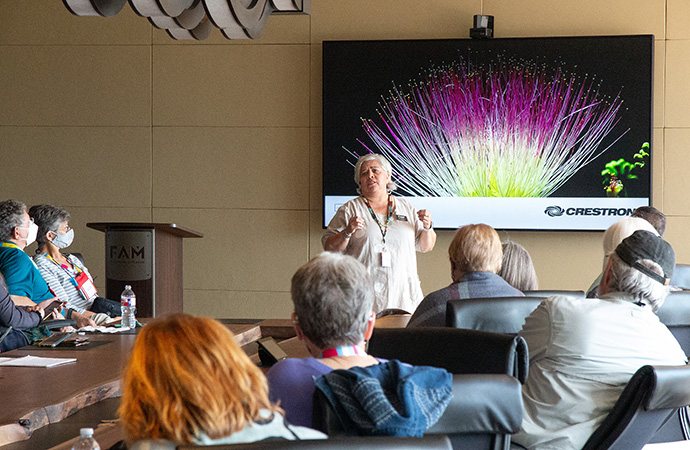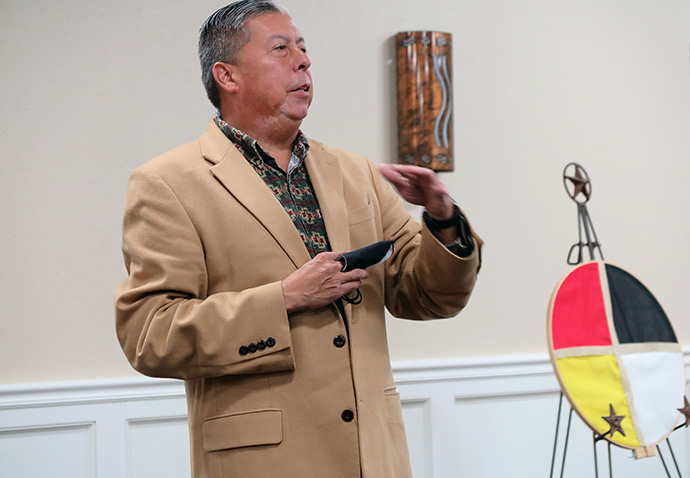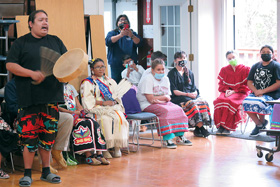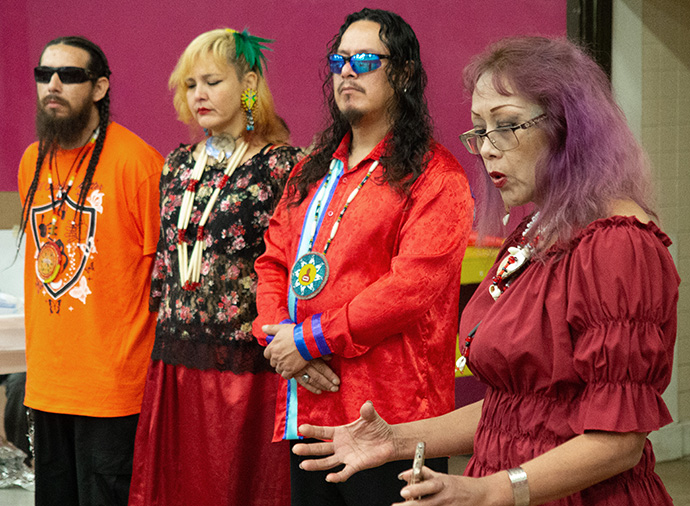Key points
- The Oklahoma Indian Missionary Conference brought together United Methodists from nine states for a deep dive into Native American ministries and challenges.
- Indigenous people today struggle with invisibility, church leaders learned.
- The immersion group discussed ways to raise awareness of the issues facing Native Americans today.
In the early morning hours of Nov. 27, 1868 — 153 years ago this week — the U.S. 7th Cavalry attacked a sleeping village of Cheyenne people, led by Peace Chief Black Kettle, on the Washita River.
Initially described as a battle, the attack was later denounced by many as a massacre. The soldiers overran the village, killing an estimated 30 to 60 Native American women, children and men, and taking 53 women and children prisoner. Twenty soldiers were killed, most of them in a group that was pursuing fleeing warriors.
Today, the site of the attack is a quiet spot along the Washita River in the rolling countryside outside Cheyenne, Oklahoma. A park ranger points to landmarks — the mound where two Native American women hid from the soldiers, the small hill where Lt. Col. George Custer watched the attack unfold, the area where soldiers slaughtered an estimated 650 horses in the village.
It is a little-known episode in U.S. history, and that fact underscores a problem for Native Americans today: invisibility.

To shine light on the challenges facing Native American communities, the Oklahoma Indian Missionary Conference of The United Methodist Church held an immersion experience Oct. 24-28. A group of 40 people, mostly United Methodists, spent the week learning about Native American history and culture, visiting ministries and discussing how the church can respond to the needs.
Drawing people from nine states, the event was the fifth and largest immersion held by the conference so far, said the Rev. David Wilson, assistant to the bishop. Bishop James Nunn, who leads the denomination’s Oklahoma Area, participated in the immersion.
Celebrating Native American heritage
November is Native American Heritage Month. Native American Day is Nov. 26. United Methodist Discipleship Ministries offers resources to help congregations celebrate. The worship resources are written by the Rev. Delana Taylor, a local pastor from the Oklahoma Indian Missionary Conference.
Native people represent a small but resilient part of the denomination, said Wilson, who is Choctaw. Native Americans account for 20,885 members, or 0.315% of the denomination’s U.S. membership, according to the church’s General Council on Finance and Administration.
“We’re often so invisible … (but) we don’t let that hinder what we do,” Wilson said.
The invisibility was driven home as the group visited the First Americans Museum in Oklahoma City. The museum, which opened Sept. 18, focuses on the history and cultures of the 39 tribes in Oklahoma — all but four of which were forcibly moved to the state from other parts of the country.
In the museum, the stories are told by Native Americans themselves through displays designed by an all-Native curatorial team. The exhibits vividly depict the way of life and cultural impact of Native people, as well as the injustices and ordeals experienced since the arrival of white people to the continent.
Senior curator Dr. heather ahtone emphasized the power of story, focusing on accounts of the creation. Each tribe has its own creation story, and each is valid, she said. Colonialism, she said, was supported by a white European interpretation of Genesis, emphasizing rights over responsibility for creation. The museum’s goal was to show Native perspectives emphasizing responsibility and not rights, she said.

Native American history has been largely erased from common knowledge in the United States, but non-indigenous people would be shocked at how much Native children know from stories that have been handed down through generations, ahtone said, citing as an example accounts of atrocities committed by Christopher Columbus.
The United States can’t move forward as a country without understanding and mutual respect, and you can’t have that when your history has been erased, she said.
“We … just want the truth to be told,” the Rev. Michael H. Svitak told the group later that day.

Svitak, North District superintendent of the Oklahoma Indian Missionary Conference and a Kiowa, said that in public schools, Native American history might get a paragraph or a page in a textbook, if that. “A lot of times, people don’t know the true stories,” he said.
One of many overlooked figures in that history is Standing Bear, a Ponca chief who became the first Native American recognized under U.S. law as a person. The immersion group visited the Standing Bear Museum and Education Center in Ponca City, Oklahoma, to learn more about the leader, whom Wilson described as the first civil rights activist. With the help of a journalist and two lawyers, Chief Standing Bear won recognition in a landmark case in U.S. District Court in Omaha, Nebraska, in 1879.
The Oklahoma Indian Missionary Conference
The Oklahoma Indian Missionary Conference has 81 churches in Oklahoma, three in Kansas, one in Missouri and one in Dallas, Texas, in addition to fellowships in Oklahoma, Kansas and Missouri. The conference has been in ministry since the 1840s. Today, salary support for pastors is a pressing need.
Three Advance specials — second-mile giving opportunities in The United Methodist Church — help support the conference:
- Parish Partners (Advance Special 583634)
- Native American Children’s Fund (Advance Special 583581)
- Construction Project Fund (Advance Special #583633)
In addition, Clinton Indian Church and Community Center is an Advance special (#3020757)
For more information on the conference, go to http://www.umc-oimc.org/.
Telling the story and breaking stereotypes is important, Wilson said. For example, he said, the perception that all Native Americans are wealthy because of reservation casinos is not true. People in the immersion group were surprised to learn there are more than 560 tribes in the United States, and they don’t all speak the same language, he said.
More attention has been focused on Native American concerns in recent years, and Wilson points to two factors: the revelation of abuses at boarding schools in the 1800s and 1900s in Canada and the United States, where indigenous children were forced to reject their culture and language, and the 2020 U.S. Supreme Court decision in McGirt v. Oklahoma, which affirmed tribal sovereignty in criminal cases that occur in tribal jurisdictions.
Native Americans have a history with Methodism that spans more than 180 years. They have persevered in the faith through the ordeal of being removed from their homelands, contending with racism, and dealing with the challenges of unemployment and economic adversity. They are still working for the Gospel of Jesus Christ, Wilson said.
In 2012, The United Methodist Church’s General Conference, its top legislative assembly, performed an act of repentance for the church’s involvement in injustices toward Native Americans. Since then, the church has also worked to atone for the Sand Creek Massacre, an 1864 attack led by a Methodist preacher against a peaceful Cheyenne and Arapaho village almost exactly four years before the Washita attack. Individual congregations and agencies have returned land to Native tribes, and efforts are underway to research and apologize for Methodist involvement in the boarding schools.
Wilson sees reasons for hope. “The hope lies in the people in the local churches that I get to connect with and see what they’re doing,” he said. “It gives you hope to know there are people with great passion to serve in this denomination and in the community.”
The challenge for the future is the lack of Native leadership and the need to raise up leaders, he said. Financial limitations are a big part of that, he said.
Programs support, develop Native American youth

Serving in a rural town of 9,000, Clinton Indian Church and Community Center is a hub for tribal life and a place of refuge for young people.
Church and school alike are working to give Native American young people a foundation in their own heritage and equip them to navigate an environment where they are not part of the dominant culture.
He wonders if Native young people will remain in the church when the older generations are gone, he said. The church’s influence in past efforts to eradicate Native languages and culture has been a challenge, he said. In addition, he noted, younger people don’t always buy into church and what it does, and they are looking for ceremonies and places that affirm their Indian-ness. Traditional practices are “still a big no-no” for older folks, but they appeal to young people, Wilson said.
Josephine Deere, a lay minister and longtime leader in the conference, said the older folks were taught by the missionaries that the ancestors didn’t worship the right way. Some people still have that mindset, but she said she is seeing baby steps toward change. “We’re still learning the better way to do things.”
The immersion group visited two programs focused on young people — a children’s and youth ministry at Clinton Indian United Methodist Church and Community Center and a public charter school in Oklahoma City, Sovereign Community School, which emphasizes Native American culture and languages.
Visiting Native American churches, the immersion group experienced hospitality and learned about local ministries as well as challenges.
The Clinton church is working to raise awareness of the culture and history of Native people, said the Rev. Donna Pewo, who has overseen the children and youth program and recently became conference director of connectional ministries.
“In order for the church as a whole to meet and understand the challenges of Native people, there must be an awareness and dialogue of past atrocities,” she said, after the group’s visit. That is needed “to build bridges of understanding and acceptance between all people and races.”
She sees hope in two mothers who broke the cycle of addiction through rehab; a young freshman at an area university who wants to pursue a medical career and return to Clinton to help her tribal people; and a mother of four who recently received a liver transplant “and has a newfound sense of her relationship with God,” she said. “These are signs of hope that bring me joy and peace.”

At Ponca Indian Mission United Methodist Church in Ponca City, the group heard from Vivian Mesteth, chapter president of Missing and Murdered Indigenous People of Northern Oklahoma, a grassroots organization focused on finding Native American people — particularly women and girls — who disappear as victims of crime. “It’s never-ending” and a nightmare, she said. The numbers of missing indigenous persons are underestimated, she said.
Being marginalized and invisible makes Native Americans targets, and their disappearances do not draw the level of media attention given to white people who disappear. At the Oklahoma Indian Missionary Conference’s annual gathering, half of the people attending raised their hands when asked if a member of their family had been murdered or gone missing, Wilson said.
Native People and The United Methodist Church
The United Methodist Church’s legislative body, the General Conference, addressed the importance of ministry with Native Americans and the church’s troubled history with indigenous people in a resolution titled “Native People and The United Methodist Church,” which can be found in the 2016 Book of Resolutions (Resolution #3321).
The Native American Comprehensive Plan works to strengthen ministries for and with Native people across the denomination. For more information, go to http://www.nacp-umc.org/.
Ponca Indian Mission Church is addressing other deep issues facing the community by working with the Ponca tribe on building tiny homes and helping people struggling with addiction through the New Hope and Recovery Center. “My hope is in God our savior,” said Brenton Carney, program manager for the Ponca tribe. “… Maybe through this center we can provide new hope to someone.”
Participants in the immersion week came away inspired.
“It touches your spirit in a way that nothing else can,” said the Rev. Karen Wheat of Kalamazoo, Michigan, who had been on a previous immersion. “It awakens the consciousness in a way that no other event really could.”
Wheat, who is retired after 45 years of ministry, said she would like her congregation to be a sister church for a Native congregation.
“Being Native, this resonates deeply,” said the Rev. Chad Johnson, a Chickasaw, who is part of the North Texas Conference Journey Toward Racial Justice and also serves at First United Methodist Church Jacksboro in North Texas. “This part of history did happen, and … there are people that feel invisible, and how do we see them?”
Members of the group agreed on the need to tell the stories and raise awareness.
“It’s come and look, and go and tell,” said the Rev. Kristen Brown, pastor of D.D. Etchieson Memorial United Methodist Church, an Oklahoma Indian Missionary Conference congregation in Tahlequah, Oklahoma. “… Now that you have different eyes to look deeper, be a part of the solution in your own community.”
Tanton is chief news officer of United Methodist Communications and director of UM News.
News contact: Tim Tanton at (615) 742-5470 or newsdesk@umcom.org. To read more United Methodist news, subscribe to the free Daily or Friday (weekly) Digests.




